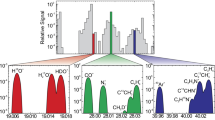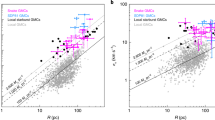Abstract
The study of extrasolar planets and of the Solar System provides complementary pieces of the mosaic represented by the process of planetary formation. Exoplanets are essential to fully grasp the huge diversity of outcomes that planetary formation and the subsequent evolution of the planetary systems can produce. The orbital and basic physical data we currently possess for the bulk of the exoplanetary population, however, do not provide enough information to break the intrinsic degeneracy of their histories, as different evolutionary tracks can result in the same final configurations. The lessons learned from the Solar System indicate us that the solution to this problem lies in the information contained in the composition of planets. The goal of the Atmospheric Remote-Sensing Infrared Exoplanet Large-survey (ARIEL), one of the three candidates as ESA M4 space mission, is to observe a large and diversified population of transiting planets around a range of host star types to collect information on their atmospheric composition. ARIEL will focus on warm and hot planets to take advantage of their well-mixed atmospheres, which should show minimal condensation and sequestration of high-Z materials and thus reveal their bulk composition across all main cosmochemical elements. In this work we will review the most outstanding open questions concerning the way planets form and the mechanisms that contribute to create habitable environments that the compositional information gathered by ARIEL will allow to tackle.






Similar content being viewed by others
References
Fressin, F., et al.: The false positive rate of Kepler and the occurrence of planets. ApJ. 766, 81 (2013)
Spiegel, D.S., Forney, J.S., Sotin, C.: Structure of exoplanets. PNAS. 111, 12622–12627 (2014)
Baines, K. H., et al.: Experiencing Venus: clues to the origin, evolution, and chemistry of terrestrial planets via in-situ exploration of our sister world. In: Esposito, L. W., Stofan, E. R., Cravens, T. E. (eds.) Exploring Venus as a Terrestrial Planet. Geophys. Monogr. 176, pp. 171–189. American Geophysical Union, Washington, D.C. (2007). https://doi.org/10.1029/176GM11
De Bergh, et al.: Deuterium on Venus - observations from Earth. Science. 251, 547–549 (1991)
Donahue, T.M., et al.: Venus was wet - a measurement of the ratio of deuterium to hydrogen. Science. 216, 630–633 (1982)
Hunten, D.M.: Venus: lessons for Earth. Adv. Space Res. 12(9), 35–41 (1992)
Fedorova, A., et al.: HDO and H2O vertical distributions and isotopic ratio in the Venus mesosphere by solar occultation at infrared spectrometer on board Venus express. J. Geophys. Res. 113, E00B22 (2008). https://doi.org/10.1029/2008JE003146
Gillmann, C., et al.: A consistent picture of early hydrodynamic escape of Venus atmosphere explaining present Ne and Ar isotopic ratios and low oxygen atmospheric content. Earth Planet. Sci. Lett. 286, 503–513 (2009)
Kopparapu, R.K., et al.: Habitable zones around main-sequence stars: new estimates. Astrophys. J. 765, 131 (2013)
Tinetti, G., et al.: ARIEL assessment study report ESA/SCI(2017), 2, (2017a). http://sci.esa.int/cosmic-vision/59109-ariel-assessment-study-report-yellow-book/#
Tinetti G., et al.: Exp. Astron. submitted (2017b)
Tinetti G., et al.: ARIEL – the atmospheric remote-sensing infrared exoplanet large-survey, proposal submitted in response to ESA’s call for the M4 mission of the cosmic vision 2015–2025. (2015). http://sci.esa.int/science-e/www/object/doc.cfm?fobjectid=56561
Morbidelli, A., Lunine, J.I., O’Brien, D.P., Raymond, S.N., Walsh, K.J.: Building terrestrial planets. Annu. Rev. Earth Planet. Sci. 40, 251–275 (2012)
Raymond, S.N., Kokubo, E., Morbidelli, A., Morishima, R., Walsh, K.J.: Terrestrial planet formation at home and abroad. In: Beuther, H., Klessen, R.S., Dullemond, C.P., Henning, T. (eds.) Protostars and Planets VI, pp. 595–618. University of Arizona Press, Tucson (2014)
D’Angelo, G., Durisen, R.H., Lissauer, J.J.: Giant planet formation, pp. 526. In: Seager, S. (ed.) Exoplanets, pp. 319–346. University of Arizona Press, Tucson (2010)
Helled, R., Bodenheimer, P., Podolak, M., Boley, A., Meru, F., Nayakshin, S., Fortney, J.J., Mayer, L., Alibert, Y., Boss, A.P.: Giant planet formation, evolution, and internal structure. In: Beuther, H., Klessen, R.S., Dullemond, C.P., Henning, T. (eds.) Protostars and Planets VI, pp. 643–665. University of Arizona Press, Tucson (2014)
Morbidelli, A., Raymond, S.N.: Challenges in planet formation. J. Geophys. Res. Planets. 121, 1962–1980 (2016)
Massol, H., et al.: Formation and evolution of protoatmospheres. Space Sci. Rev. 205, 153–211 (2016)
Madhusudhan, N., Agundez, M., Moses, J.I., Yongyun, H.: Exoplanetary atmospheres– chemistry, formation conditions, and habitability. Space Sci. Rev. 205, 285–348 (2016)
Meyer, M.R.: Circumstellar disk evolution: constraining theories of planet formation. Proc. Int. Astron. Union. 4, 111–122 (2008)
Fedele, D., van den Ancker, M.E., Henning, T., Jayawardhana, R., Oliveira, J.M.: Timescale of mass accretion in pre-main-sequence stars. Astron. Astrophys. 510, A72 (2010)
Fegley B., Schaefer L.: Cosmochemisty. In: Goswami, A., Reddy, B. (eds.) Principles and Perspectives in Cosmochemistry. Astrophysics and Space Science Proceedings, pp. 347–378, Springer-Verlag, Berlin, Heidelberg, (2010). https://doi.org/10.1007/978-3-642-10352-0_7
Zingales, T., et al.: Technical note ARIEL-UCL-SCI-TN-001 delivered to the European Space Agency in support to the ARIEL assessment study report (ESA document: ESA/SCI(2017) 2). (2017a). Document available at: https://arielspacemission.files.wordpress.com/2017/05/ariel-ice-gs-tn-001_arielplanning-i1-01.pdf. Accessed 27 June 2017
Zingales, T., Tinetti, G., Pillitteri, I., Leconte, J., Micela, G., Sarkar, S.: The ARIEL mission reference sample. Exp. Astron. (2018). https://doi.org/10.1007/s10686-018-9572-7
Guillot, T., Gladman, B.: Late planetesimal delivery and the composition of giant planets. In: Disks, planetesimals, and planets, ASP conference proceedings, vol. 219, Astronomical Society of the Pacific, p. 475. (2000)
Rocchetto, M., et al.: Exploring biases of atmospheric retrievals in simulated JWST transmission spectra of hot Jupiters. ApJ. 833, 120–133 (2016)
Barstow J. K., et al.: ARIEL-UCL-SCI-TN-002 technical note for the ARIEL assessment study report ESA/SCI(2017) 2. (2017)
Chambers, J.E.: Oligarchic growth with migration and fragmentation. Icarus. 198, 256–273 (2008)
Baruteau, C., Bai, X., Mordasini, C., Molliere, P.: Formation, orbital and internal evolution of young planetary systems. Space Sci. Rev. 205, 77–124 (2016)
Rasio, F.A., Ford, E.B.: Dynamical instabilities and the formation of extrasolar planetary systems. Science. 274, 954–956 (1996)
Weidenschilling, S.J., Marzari, F.: Gravitational scattering as a possible origin for giant planets at small stellar distances. Nature. 384, 619–621 (1996)
Taylor, F.W., et al.: The composition of the atmosphere of Jupiter. In: Bagenal, F., Dowling, T. E., McKinnon, W. B. (eds.) Jupiter. The Planet, Satellites and Magnetosphere, p. 59–78. Cambridge University Press, Cambridge, (2004)
Turrini, D., Nelson, R.P., Barbieri, M.: The role of planetary formation and evolution in shaping the composition of exoplanetary atmospheres. Exp. Astron. 40, 501–522 (2015)
Limbach, M.A., Turner, E.L.: Exoplanet orbital eccentricity: multiplicity relation and the solar system. PNAS. 112, 20–24 (2015)
Zinzi, A., Turrini, D.: Anti-correlation between multiplicity and orbital properties in exoplanetary systems as a possible record of their dynamical histories. A&A. 605, L4 (2017)
Espinoza, N., et al.: Metal enrichment leads to low atmospheric C/O ratios in transiting giant exoplanets. Submitted to ApJL, eprint arXiv:1611.08616 (2016)
Miguel, Y., Kaltenegger, L., Fegley, B., Schaefer, L.: Compositions of hot super-earth atmospheres: exploring Kepler candidates. ApJL. 742, L19 (2011)
Panić, O., Min, M.: Effects of disc mid-plane evolution on CO snowline location. MNRAS. 467, 1175–1185 (2017)
Guillot, T., Hueso, R.: The composition of Jupiter: sign of a (relatively) late formation in a chemically evolved protosolar disc. MNRAS. 367, L47–L51 (2006)
Atreya, S., et al.: The origin and evolution of Saturn, with exoplanet perspective. In: Baines, K. H., Flasar, F. M., Krupp, N., Stallard, T. S. (eds.) Saturn in the 21 Century. Cambridge University Press, Cambridge (2016)
Hersant, F., Gautier, D., Lunine, J.I.: Enrichment in volatiles in the giant planets of the solar system. PSS. 52, 623–641 (2004)
Miguel, Y., Guillot, T., Fayon, L.: Jupiter internal structure: the effect of different equations of state. A&A. 596, A114 (2016)
Johansen, A., Blum, J., Tanaka, H., Ormel, C., Bizzarro, M., Rickman, H.: The multifaceted planetesimal formation process. In: Beuther, H., Klessen, R.S., Dullemond, C.P., Henning, T. (eds.) Protostars and Planets VI, pp. 547–570. University of Arizona Press, Tucson (2014)
Scott, E.R.D.: Chondrites and the protoplanetary disk. Annu. Rev. Earth Planet. Sci. 35, 577–620 (2007)
Brasser, R.: The formation of Mars: building blocks and accretion time scale. Space Sci. Rev. 174, 11–25 (2013)
Raymond, S.N., Izidoro, A.: Origin of water in the inner solar system: planetesimals scattered inward during Jupiter and Saturn’s rapid gas accretion. Icarus. 297, 134–148 (2017)
Turrini, D., Svetsov, V.: The formation of jupiter, the jovian early bombardment and the delivery of water to the asteroid belt: the case of (4) Vesta. Life. 4, 4–34 (2014)
Drake, M.J.: Origin of water in the terrestrial planets. MAPS. 40, 519–527 (2005)
Quintana, E.V., Lissauer, J.J.: The effect of planets beyond the ice line on the accretion of volatiles by habitable-zone rocky planets. ApJ. 786, 33 (2014)
Gillon, M., et al.: Seven temperate terrestrial planets around the nearby ultracool dwarf star TRAPPIST-1. Nature. 542, 456–460 (2017)
Acknowledgments
D. Turrini and P. Wolkenberg gratefully acknowledge the support of the European Space Agency (ESA) during their participation to ARIEL’s ESA Science Study Team. D. Turrini has been supported by the Italian Space Agency (ASI) under the contract 2015-038-R.0. The work of O. Panić has been supported through a Royal Society Dorothy Hodgkin Fellowship. A. Piccialli has received funding from the European Union’s Horizon 2020 Programme (H2020-Compet-08-2014) under grant agreement UPWARDS-633127.
Author information
Authors and Affiliations
Corresponding author
Rights and permissions
About this article
Cite this article
Turrini, D., Miguel, Y., Zingales, T. et al. The contribution of the ARIEL space mission to the study of planetary formation. Exp Astron 46, 45–65 (2018). https://doi.org/10.1007/s10686-017-9570-1
Received:
Accepted:
Published:
Issue Date:
DOI: https://doi.org/10.1007/s10686-017-9570-1




